An Epigenomic Meta-Analysis of Differentially Methylated Sites in Pre- and Post-Metabolic/Bariatric Surgery Adult Female Patients
Abstract
1. Introduction
2. Results
2.1. Summary of Reviewed Studies
2.2. Risk of Bias Assessment
2.3. The Analysis of All Methylation Changes Post-Metabolic/Bariatric Surgery
2.4. Differentially Methylated Sites Linked to Metabolic Pathways Were Associated with Successful Weight Loss After Metabolic/Bariatric Surgery
2.5. The Highlights of Potential Epigenetic Signatures in Three Tissue Types
2.6. Genetic Variations Linked with Differentially Methylated CpG Sites
3. Discussion
3.1. Strengths and Limitations
3.2. Implications for Future Research
4. Materials and Methods
4.1. Search Strategy
4.2. Inclusion and Exclusion Criteria
4.3. Study Selection
4.4. Risk of Bias Assessment and Evidence Quality Grading
4.5. Data Extraction
4.6. Data Quality Control
4.7. KEGG Enrichment Analysis
4.8. Differentially Methylated Loci Among Analyzed Tissues
4.9. In-Silico Identification of DNA Sequence Variation Derived from the Epigenomic Meta-Analysis
5. Conclusions
Supplementary Materials
Author Contributions
Funding
Institutional Review Board Statement
Informed Consent Statement
Data Availability Statement
Acknowledgments
Conflicts of Interest
Abbreviations
| 5hmC | 5-Hydroxymethylcytosine |
| ADAP1 | ArfGAP with dual PH domains 1 |
| ARGP | agouti-related neuropeptide gene |
| AKT1 | AKT serine/threonine kinase 1 |
| AKT2 | AKT serine/threonine kinase 2 |
| ALDH1A3 | aldehyde dehydrogenase 1 family member A3 |
| BCL2 | BCL2 apoptosis regulator |
| C2CD4B | C2 calcium-dependent domain-containing 4B |
| cAMP | cyclic AMP |
| CFAP44 | cilia and flagella-associated protein 44 |
| COL4A1 | collagen type IV alpha 1 chain |
| DNAJC5G | DnaJ heat shock protein family member C5 gamma |
| EMX2OS | opposite strand/antisense RNA |
| EWAS | epigenome-wide association studies |
| EWL | excess weight loss |
| FHOD3 | formin homology 2 domain-containing 3 |
| FoxO | forkhead box O |
| FOXO1 | Forkhead box O1 |
| GHRL | Ghrelin |
| IL6 | interleukin 6 |
| KEGG | Kyoto Encyclopaedia of Genes and Genomes pathway analysis |
| LEP | Leptin |
| LEPR | Leptin receptor |
| LINE1 | long interspersed element-1 |
| LPIN1 | Lipin 1 |
| LRP5 | LDL receptor-related protein 5 |
| MAGEL2 | MAGE family member L2 |
| MAPK10 | mitogen-activated protein kinase 10 |
| MEDLINE | Medical Literature Analysis and Retrieval System Online |
| mTOR | mammalian target of rapamycin |
| NHS | National Health Service |
| OBSCN | obscurin, cytoskeletal calmodulin, and titin-interacting RhoGEF |
| OSMR | oncostatin M receptor |
| OVAT | visceral adipose tissue |
| PABPC1 | poly(A) binding protein cytoplasmic 1 |
| PI3K-Akt | phosphatidylinositol 3-kinase/protein kinase B |
| PIK3R1 | phosphoinositide-3-kinase regulatory subunit 1 |
| PIK3R2 | phosphoinositide-3-kinase regulatory subunit 2 |
| PITX2 | paired like homeodomain 2 |
| PKN2 | protein kinase N2 |
| POMC | Proopiomelanocortin |
| PRISMA-P | Preferred Reporting Items for Systematic Review and Meta-Analysis Protocols |
| PRKAB2 | protein kinase AMP-activated non-catalytic subunit beta 2 |
| PRKAG2 | protein kinase AMP-activated non-catalytic subunit gamma 2 |
| RRBS | reduced-representation bisulfite sequencing |
| SAT | subcutaneous adipose tissue |
| SERPINE-1 | serpin family E member 1 |
| SGK1 | serum/glucocorticoid-regulated kinase 1 gene |
| SIM1 | SIM bHLH transcription factor 1 |
| SNPs | single-nucleotide polymorphisms |
| SORBS3 | sorbin and SH3 domain-containing 3 gene |
| T2D | type 2 diabetes |
| TLR1 | Toll-like receptor 1 |
| TRAF6 | TNF receptor-associated factor 6 |
| VEGFC | vascular endothelial growth factor C |
| Wnt10b | Wnt family member 10B |
| Wnt5b | Wnt family member 5B |
References
- WHO. World Obesity Day 2022—Accelerating Action to Stop Obesity. Updated 4 March 2022. Available online: https://www.who.int/news/item/04-03-2022-world-obesity-day-2022-accelerating-action-to-stop-obesity (accessed on 8 January 2024).
- Sarma, S.; Sockalingam, S.; Dash, S. Obesity as a multisystem disease: Trends in obesity rates and obesity-related complications. Diabetes Obes. Metab. 2021, 23, 3–16. [Google Scholar] [CrossRef]
- Van Dijk, S.J.; Molloy, P.L.; Varinli, H.; Morrison, J.L.; Muhlhausler, B.S. Epigenetics and human obesity. Int. J. Obes. 2015, 39, 85–97. [Google Scholar] [CrossRef]
- National Institute for Health and Care Excellence (NICE). Weight Management: Lifestyle Services for Overweight or Obese Adults. 2014. Available online: https://www.nice.org.uk/guidance/ph53 (accessed on 8 January 2024).
- Cadena-Obando, D.; Ramírez-Rentería, C.; Ferreira-Hermosillo, A.; Albarrán-Sanchez, A.; Sosa-Eroza, E.; Molina-Ayala, M.; Espinosa-Cárdenas, E. Are there really any predictive factors for a successful weight loss after bariatric surgery? BMC Endocr. Disord. 2020, 20, 20. [Google Scholar] [CrossRef]
- Chou, J.J.; Lee, W.J.; Almalki, O.; Chen, J.C.; Tsai, P.L.; Yang, S.H. Dietary intake and weight changes 5 years after laparoscopic sleeve gastrectomy. Obes. Surg. 2017, 27, 3240–3246. [Google Scholar] [CrossRef]
- Al-Bader, I.; Khoursheed, M.; Al Sharaf, K.; Mouzannar, D.A.; Ashraf, A.; Fingerhut, A. Revisional laparoscopic gastric pouch resizing for inadequate weight loss after Roux-en-Y gastric bypass. Obes. Surg. 2015, 25, 1103–1108. [Google Scholar] [CrossRef] [PubMed]
- Bouchard-Mercier, A.; de Toro-Martín, J.; Nadeau, M.; Lescelleur, O.; Lebel, S.; Richard, D.; Biertho, L.; Tchernof, A.; Vohl, M.-C. Molecular remodeling of adipose tissue is associated with metabolic recovery after weight loss surgery. J. Transl. Med. 2022, 20, 283. [Google Scholar] [CrossRef] [PubMed]
- de la Escalera, L.M.; Kyrou, I.; Vrbikova, J.; Hainer, V.; Sramkova, P.; Fried, M.; Piya, M.K.; Kumar, S.; Tripathi, G.; McTernan, P.G. Impact of gut hormone FGF-19 on type-2 diabetes and mitochondrial recovery in a prospective study of obese diabetic women undergoing bariatric surgery. BMC Med. 2017, 15, 34. [Google Scholar] [CrossRef] [PubMed]
- Gancheva, S.; Ouni, M.; Jelenik, T.; Koliaki, C.; Szendroedi, J.; Toledo, F.G.S.; Markgraf, D.F.; Pesta, D.H.; Mastrototaro, L.; De Filippo, E.; et al. Dynamic changes of muscle insulin sensitivity after metabolic surgery. Nat. Commun. 2019, 10, 4179. [Google Scholar] [CrossRef]
- Dearden, L.; Bouret, S.G.; Ozanne, S.E. Sex and gender differences in developmental programming of metabolism. Mol. Metab. 2018, 15, 8–19. [Google Scholar] [CrossRef]
- Andersson, D.P.; Tseng, B.T.; Arner, P.; Dahlman, I. Long-term improvement of adipocyte insulin action during body weight relapse after bariatric surgery: A longitudinal cohort study. Surg. Obes. Relat. Dis. 2022, 18, 683–692. [Google Scholar] [CrossRef]
- Houseman, E.A.; Kile, M.L.; Christiani, D.C.; Ince, T.A.; Kelsey, K.T.; Marsit, C.J. Reference-free deconvolution of DNA methylation data and mediation by cell composition effects. BMC Bioinform. 2016, 17, 259. [Google Scholar] [CrossRef]
- Day, S.E.; Garcia, L.A.; Coletta, R.L.; Campbell, L.E.; Benjamin, T.R.; De Filippis, E.A.; Madura, J.A., 2nd; Mandarino, L.J.; Roust, L.R.; Coletta, D.K. Alterations of sorbin and SH3 domain containing 3 (SORBS3) in human skeletal muscle following Roux-en-Y gastric bypass surgery. Clin. Epigenetics 2017, 9, 96. [Google Scholar] [CrossRef]
- Garcia, L.A.; Day, S.E.; Coletta, R.L.; Campos, B.; Benjamin, T.R.; De Filippis, E.; Madura, J.A.; Mandarino, L.J.; Roust, L.R.; Coletta, D.K. Weight loss after Roux-En-Y gastric bypass surgery reveals skeletal muscle DNA methylation changes. Clin. Epigenetics 2021, 13, 100. [Google Scholar] [CrossRef]
- Nicoletti, C.F.; Nonino, C.B.; de Oliveira, B.A.P.; Pinhel, M.A.d.S.; Mansego, M.L.; Milagro, F.I.; Zulet, M.A.; Martinez, J.A. DNA methylation and hydroxymethylation levels in relation to two weight loss strategies: Energy-restricted diet or bariatric surgery. Obes. Surg. 2016, 26, 603–611. [Google Scholar] [CrossRef]
- Wolf, L.S.; Nicoletti, C.F.; Noronha, N.Y.; Pinhel, M.A.d.S.; Welendorf, C.R.; Delfino, H.B.P.; Junior, W.S.; Nonino, C.B. Roux-en-Y Gastric Bypass Can Modulate Methylation Level of Ghrelin Gene: A 6-Month Longitudinal Study. SN Compr. Clin. Med. 2022, 4, 210. [Google Scholar] [CrossRef]
- Benton, M.C.; Johnstone, A.; Eccles, D.; Harmon, B.; Hayes, M.T.; Lea, R.A.; Griffiths, L.; Hoffman, E.P.; Stubbs, R.S.; Macartney-Coxson, D. An analysis of DNA methylation in human adipose tissue reveals differential modification of obesity genes before and after gastric bypass and weight loss. Genome Biol. 2015, 16, 8. [Google Scholar] [CrossRef]
- Bonnefond, A.; Raimondo, A.; Stutzmann, F.; Ghoussaini, M.; Ramachandrappa, S.; Bersten, D.C.; Durand, E.; Vatin, V.; Balkau, B.; Lantieri, O.; et al. Loss-of-function mutations in SIM1 contribute to obesity and Prader-Willi–like features. J. Clin. Investig. 2013, 123, 3037–3041. [Google Scholar] [CrossRef] [PubMed]
- Kuo, T.; Kraakman, M.J.; Damle, M.; Gill, R.; Lazar, M.A.; Accili, D. Identification of C2CD4A as a human diabetes susceptibility gene with a role in β cell insulin secretion. Proc. Natl. Acad. Sci. USA 2019, 116, 20033–20042. [Google Scholar] [CrossRef] [PubMed]
- Bischof, J.M.; Stewart, C.L.; Wevrick, R. Inactivation of the mouse Magel2 gene results in growth abnormalities similar to Prader-Willi syndrome. Hum. Mol. Genet. 2007, 16, 2713–2719. [Google Scholar] [CrossRef]
- Ewell, S. ADAP1 and Arf6 Mediate Regulated Secretory Trafficing in Neurosecretory Cells and Neurons. 2013. Available online: https://digitalcommons.library.uab.edu/etd-collection/1618/ (accessed on 8 January 2024).
- Liu, X.; Li, K.; Wang, L.; Zhang, M.; Wang, X. Variations of human heat shock proteins in multiple cancers. Clin. Transl. Med. 2021, 11, e320. [Google Scholar] [CrossRef]
- Zemorshidi, F.; Töpf, A.; Claeys, K.G.; McFarlane, A.; Patton, A.; Nafissi, S.; Straub, V. Novel OBSCN variants associated with a risk to exercise-intolerance and rhabdomyolysis. Neuromuscul. Disord. 2024, 34, 83–88. [Google Scholar] [CrossRef]
- Lamiquiz-Moneo, I.; Mateo-Gallego, R.; Bea, A.M.; Dehesa-García, B.; Pérez-Calahorra, S.; Marco-Benedí, V.; Baila-Rueda, L.; Laclaustra, M.; Civeira, F.; Cenarro, A. Genetic predictors of weight loss in overweight and obese subjects. Sci. Rep. 2019, 9, 10770. [Google Scholar] [CrossRef]
- Velázquez-Fernández, D.; Mercado-Celis, G.; Flores-Morales, J.; Clavellina-Gaytán, D.; Vidrio, R.; Vidrio, E.; Mosti, M.; Sánchez-Aguilar, H.; Rodriguez, D.; León, P.; et al. Analysis of gene candidate SNP and ancestral origin associated to obesity and postoperative weight loss in a cohort of obese patients undergoing RYGB. Obes. Surg. 2017, 27, 1481–1492. [Google Scholar] [CrossRef]
- Zeng, C.P.; Lin, X.; Peng, C.; Zhou, L.; You, H.M.; Shen, J.; Deng, H.W. Identification of novel genetic variants for type 2 diabetes, childhood obesity, and their pleiotropic loci. J. Hum. Genet. 2019, 64, 369–377. [Google Scholar] [CrossRef]
- Vitolo, E.; Santini, E.; Seghieri, M.; Giannini, L.; Coppedè, F.; Rossi, C.; Dardano, A.; Solini, A. Heterozygosity for the rs696217 SNP in the preproghrelin gene predicts weight loss after bariatric surgery in severely obese individuals. Obes. Surg. 2017, 27, 961–967. [Google Scholar] [CrossRef]
- Ghalandari, H.; Hosseini-Esfahani, F.; Mirmiran, P. The association of polymorphisms in leptin/leptin receptor genes and ghrelin/ghrelin receptor genes with overweight/obesity and the related metabolic disturbances: A review. Int. J. Endocrinol. Metab. 2015, 13, e19073. [Google Scholar] [CrossRef] [PubMed]
- Loh, N.Y.; Neville, M.J.; Marinou, K.; Hardcastle, S.A.; Fielding, B.A.; Duncan, E.L.; McCarthy, M.I.; Tobias, J.H.; Gregson, C.L.; Karpe, F.; et al. LRP5 regulates human body fat distribution by modulating adipose progenitor biology in a dose-and depot-specific fashion. Cell Metab. 2015, 21, 262–273. [Google Scholar] [CrossRef]
- Cadena-López, R.O.; Hernández-Rodríguez, L.V.; Aguilar-Galarza, A.; García-Muñoz, W.; Haddad-Talancón, L.; Anzures-Cortes, M.d.L.; Velázquez-Sánchez, C.; Flores-Viveros, K.L.; Anaya-Loyola, M.A.; García-Gasca, T.; et al. Association between SNPs in leptin pathway genes and anthropometric, biochemical, and dietary markers related to obesity. Genes 2022, 13, 945. [Google Scholar] [CrossRef] [PubMed]
- Wu, F.Y.; Yin, R.X. Recent progress in epigenetics of obesity. Diabetol. Metab. Syndr. 2022, 14, 71. [Google Scholar] [CrossRef]
- Woods, S.C.; Seeley, R.J. Adiposity signals and the control of energy homeostasis. Nutrition 2000, 16, 894–902. [Google Scholar] [CrossRef] [PubMed]
- Prokop, J.W.; Duff, R.J.; Ball, H.C.; Copeland, D.L.; Londraville, R.L. Leptin and leptin receptor: Analysis of a structure to function relationship in interaction and evolution from humans to fish. Peptides 2012, 38, 326–336. [Google Scholar] [CrossRef] [PubMed]
- Villanueva, E.C.; Myers, M.G. Leptin receptor signaling and the regulation of mammalian physiology. Int. J. Obes. 2008, 32, S8–S12. [Google Scholar] [CrossRef] [PubMed]
- Kharbanda, C.; Bansal, S.; Aneja, P.S. Role and significance of ghrelin and leptin in hunger, satiety, and energy homeostasis. J. Sci. Soc. 2022, 49, 12–16. [Google Scholar] [CrossRef]
- Šebunova, N.; Štšepetova, J.; Kullisaar, T.; Suija, K.; Rätsep, A.; Junkin, I.; Soeorg, H.; Lember, M.; Sillakivi, T.; Mändar, R. Changes in adipokine levels and metabolic profiles following bariatric surgery. BMC Endocr. Disord. 2022, 22, 33. [Google Scholar] [CrossRef] [PubMed]
- Li, Y.; Ma, Z.; Jiang, S.; Hu, W.; Li, T.; Di, S.; Wang, D.; Yang, Y. A global perspective on FOXO1 in lipid metabolism and lipid-related diseases. Prog. Lipid Res. 2017, 66, 42–49. [Google Scholar] [CrossRef]
- Longo, K.A.; Wright, W.S.; Kang, S.; Gerin, I.; Chiang, S.-H.; Lucas, P.C.; Opp, M.R.; MacDougald, O.A. Wnt10b inhibits development of white and brown adipose tissues. J. Biol. Chem. 2004, 279, 35503–35509. [Google Scholar] [CrossRef]
- Montazeri, M.; Zarkesh, M.; Zadeh-Vakili, A.; Khalili, D.; Movahedi, M.; Khalaj, A. Association of physical activity with increased PI3K and Akt mRNA levels in adipose tissues of obese and non-obese adults. Sci. Rep. 2023, 13, 9291. [Google Scholar] [CrossRef]
- Elks, C.M.; Zhao, P.; Grant, R.W.; Hang, H.; Bailey, J.L.; Burk, D.H.; McNulty, M.A.; Mynatt, R.L.; Stephens, J.M. Loss of oncostatin M signaling in adipocytes induces insulin resistance and adipose tissue inflammation in vivo. J. Biol. Chem. 2016, 291, 17066–17076. [Google Scholar] [CrossRef]
- Karaman, S.; Hollmén, M.; Yoon, S.Y.; Alkan, H.F.; Alitalo, K.; Wolfrum, C.; Detmar, M. Transgenic overexpression of VEGF-C induces weight gain and insulin resistance in mice. Sci. Rep. 2016, 6, 31566. [Google Scholar] [CrossRef]
- Tinahones, F.J.; Coín Aragüez, L.; Murri, M.; Oliva Olivera, W.; Mayas Torres, M.D.; Barbarroja, N.; Gomez Huelgas, R.; Malagón, M.M.; El Bekay, R. Caspase induction and BCL2 inhibition in human adipose tissue: A potential relationship with insulin signaling alteration. Diabetes Care 2013, 36, 513–521. [Google Scholar] [CrossRef]
- Reggio, S.; Rouault, C.; Poitou, C.; Bichet, J.C.; Prifti, E.; Bouillot, J.L.; Rizkalla, S.; Lacasa, D.; Tordjman, J.; Clément, K. Increased basement membrane components in adipose tissue during obesity: Links with TGFβ and metabolic phenotypes. J. Clin. Endocrinol. Metab. 2016, 101, 2578–2587. [Google Scholar] [CrossRef]
- LaPoint, A.; Singer, J.M.; Ferguson, D.; Shew, T.M.; Renkemeyer, M.K.; Palacios, H.; Field, R.; Shankaran, M.; Smith, G.I.; Yoshino, J.; et al. Adipocyte lipin 1 is positively associated with metabolic health in humans and regulates systemic metabolism in mice. bioRxiv 2023. [Google Scholar] [CrossRef] [PubMed]
- Hinte, L.C.; Castellano-Castillo, D.; Ghosh, A.; Melrose, K.; Gasser, E.; Noé, F.; Massier, L.; Dong, H.; Sun, W.; Hoffmann, A.; et al. Adipose tissue retains an epigenetic memory of obesity after weight loss. Nature 2024, 636, 457–465. [Google Scholar] [CrossRef] [PubMed]
- Sachan, A.; Singh, A.; Shukla, S.; Aggarwal, S.; Mir, I.; Yadav, R. An immediate post op and follow up assessment of circulating adipo-cytokines after bariatric surgery in morbid obesity. Metab. Open 2022, 13, 100147. [Google Scholar] [CrossRef] [PubMed]
- Acosta-Martinez, M.; Cabail, M.Z. The PI3K/Akt pathway in meta-inflammation. Int. J. Mol. Sci. 2022, 3, 15330. [Google Scholar] [CrossRef]
- Ahmad, R.; Al-Mass, A.; Atizado, V.; Al-Hubail, A.; Al-Ghimlas, F.; Al-Arouj, M.; Bennakhi, A.; Dermime, S.; Behbehani, K. Elevated expression of the toll like receptors 2 and 4 in obese individuals: Its significance for obesity-induced inflammation. J. Inflamm. 2012, 9, 48. [Google Scholar] [CrossRef]
- Reichert, B.; Yasmeen, R.; Jeyakumar, S.M.; Yang, F.; Thomou, T.; Alder, H.; Duester, G.; Maiseyeu, A.; Mihai, G.; Harrison, E.H.; et al. Concerted action of aldehyde dehydrogenases influences depot-specific fat formation. Mol. Endocrinol. 2011, 25, 799–809. [Google Scholar] [CrossRef]
- Son, J.; Du, W.; Esposito, M.; Shariati, K.; Ding, H.; Kang, Y.; Accili, D. Genetic and pharmacologic inhibition of ALDH1A3 as a treatment of β-cell failure. Nat. Commun. 2023, 14, 558. [Google Scholar] [CrossRef]
- Sterne, J.A.C.; Davey Smith, G. Sifting the evidence—What’s wrong with significance tests? Br. Med. J. 2001, 322, 226–231. [Google Scholar] [CrossRef]
- Faul, F.; Erdfelder, E.; Buchner, A.; Lang, A.-G. Statistical power analyses using G*Power 3.1: Tests for correlation and regression analyses. Behav. Res. Methods 2009, 41, 1149–1160. [Google Scholar] [CrossRef]
- Johnstone, D.M.; Riveros, C.; Heidari, M.; Graham, R.M.; Trinder, D.; Berretta, R.; Olynyk, J.K.; Scott, R.J.; Moscato, P.; Milward, E.A. Evaluation of different normalization and analysis procedures for Illumina gene expression microarray data involving small changes. Microarrays 2013, 2, 131–152. [Google Scholar] [CrossRef]
- Fan, S.; Li, C.; Ai, R.; Wang, M.; Firestein, G.S.; Wang, W. Computationally expanding infinium HumanMethylation450 BeadChip array data to reveal distinct DNA methylation patterns of rheumatoid arthritis. Bioinformatics 2016, 32, 1773–1778. [Google Scholar] [CrossRef] [PubMed]
- Wu, Y.L.; Lin, Z.J.; Li, C.C.; Lin, X.; Shan, S.K.; Guo, B.; Zheng, M.H.; Li, F.; Yuan, L.Q.; Li, Z.H. Epigenetic regulation in metabolic diseases: Mechanisms and advances in clinical study. Signal Transduct. Target. Ther. 2023, 8, 98. [Google Scholar] [CrossRef] [PubMed]
- Higgins, J.P.T.; Thomas, J.; Chandler, J. Cochrane Handbook for Systematic Reviews of Interventions Version 6.4. 2023. Available online: https://www.cochrane.org/authors/handbooks-and-manuals/handbook (accessed on 8 January 2024).
- McGuinness, L.A.; Higgins, J.P. Risk-of-bias VISualization (robvis): An R package and Shiny web app for visualizing risk-of-bias assessments. Res. Synth. Methods 2021, 12, 55–61. [Google Scholar] [CrossRef]
- Benjamini, Y.; Hochberg, Y. Controlling the false discovery rate: A practical and powerful approach to multiple testing. J. R. Stat. Soc. Ser. B 1995, 57, 289–300. [Google Scholar] [CrossRef]
- Bonferroni, C.E. Teoria statistica delle classi e calcolo delle probabilità. In Pubblicazioni del R Istituto Superiore di Scienze Economiche e Commerciali di Firenze (In Italian); Seeber: Florence, Italy, 1926; Volume 8, pp. 3–62. [Google Scholar]
- Min, J.L.; Hemani, G.; Hannon, E.; Dekkers, K.F.; Castillo-Fernandez, J.; Luijk, R.; Carnero-Montoro, E.; Lawson, D.J.; Burrows, K.; Suderman, M.; et al. Genomic and phenotypic insights from an atlas of genetic effects on DNA methylation. Nat. Genet. 2021, 53, 1311–1321. [Google Scholar] [CrossRef]

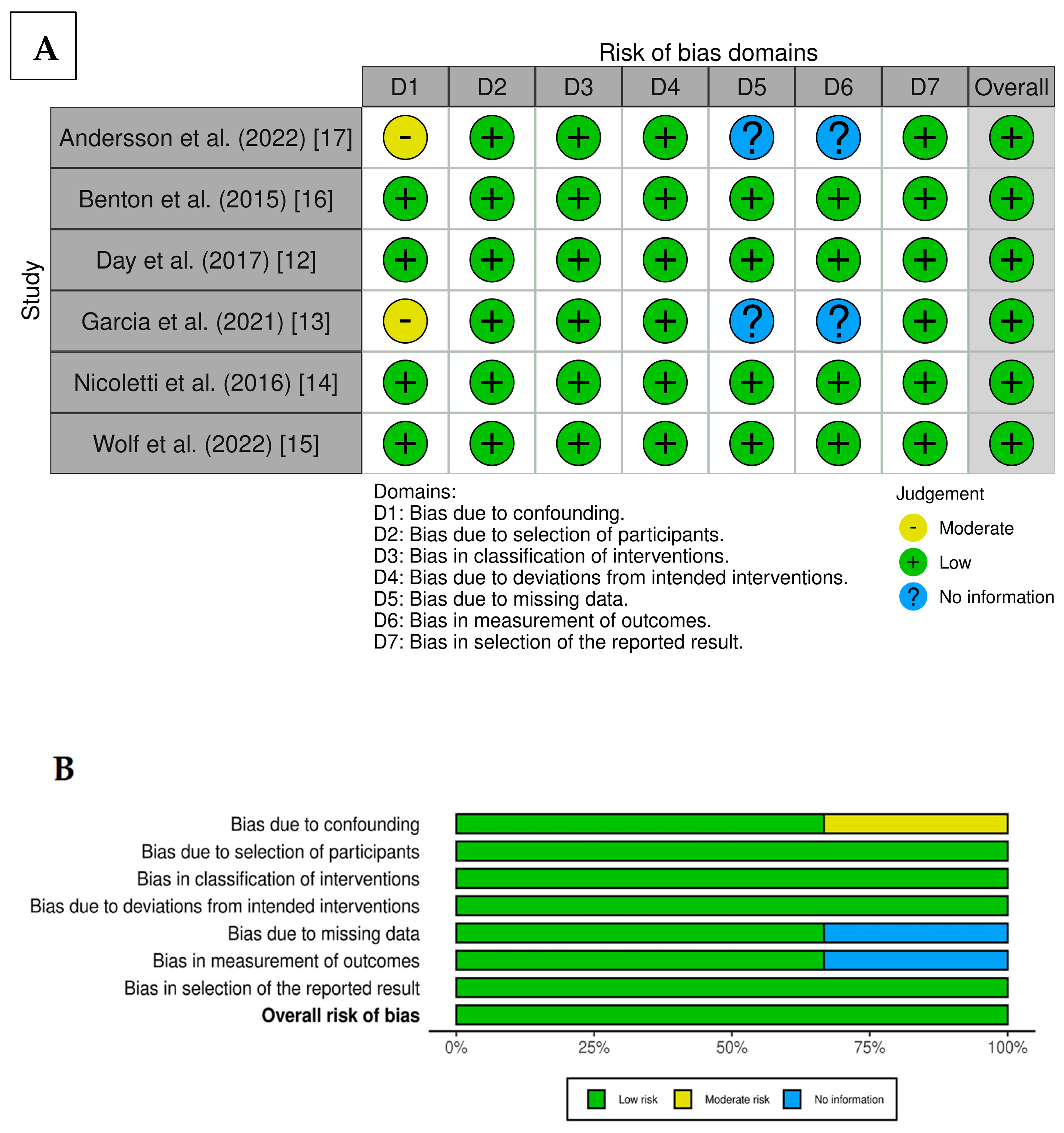

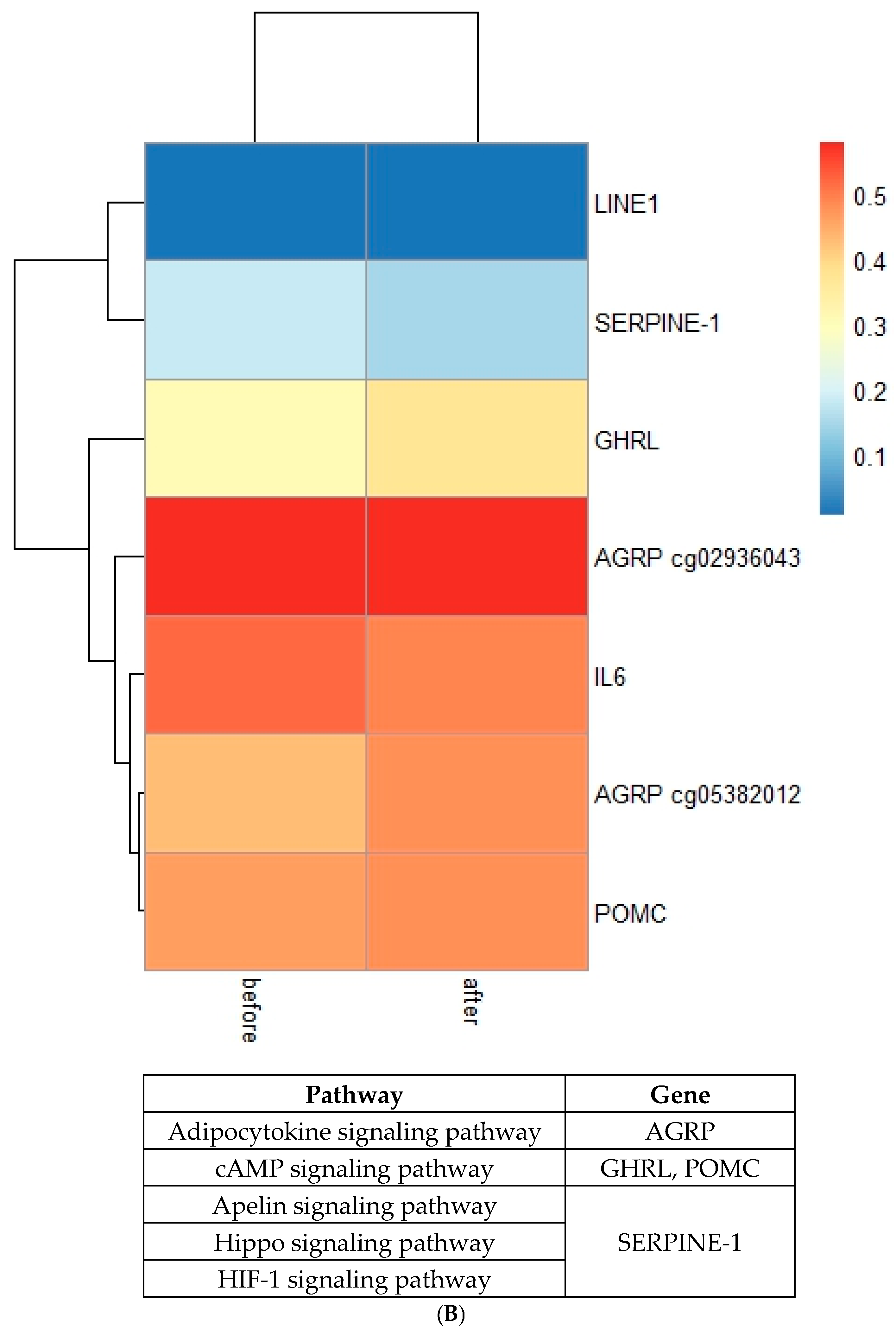
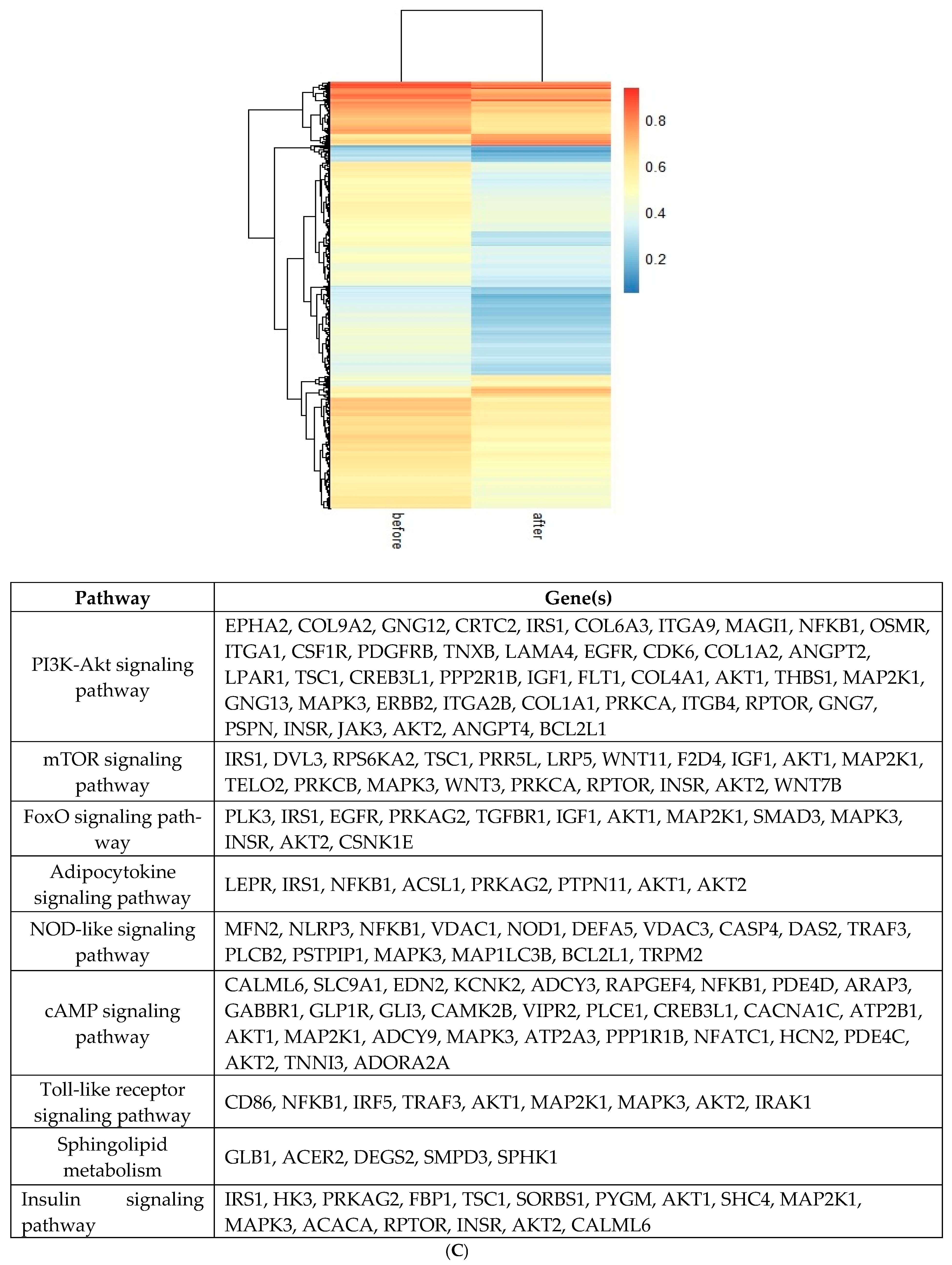
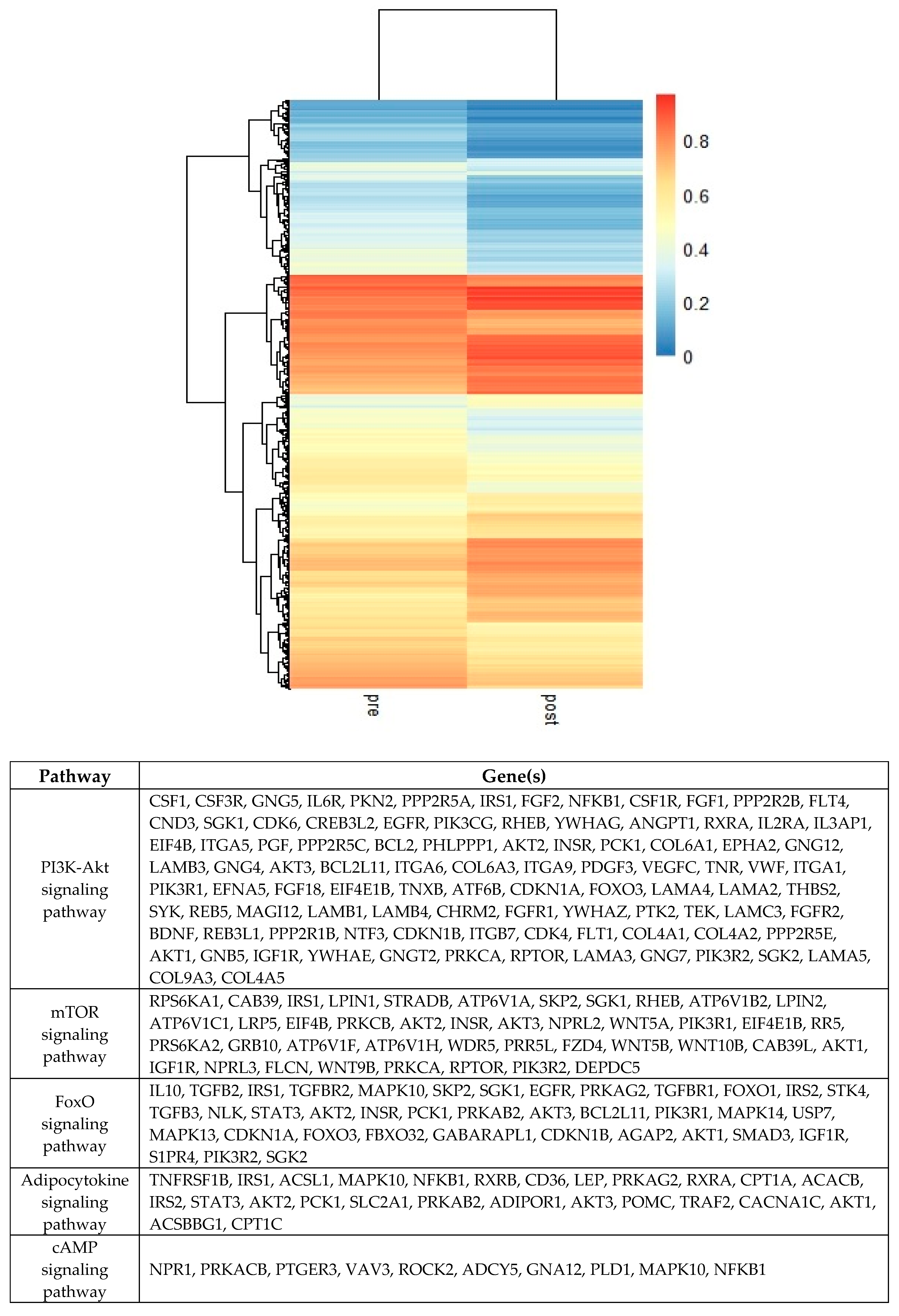



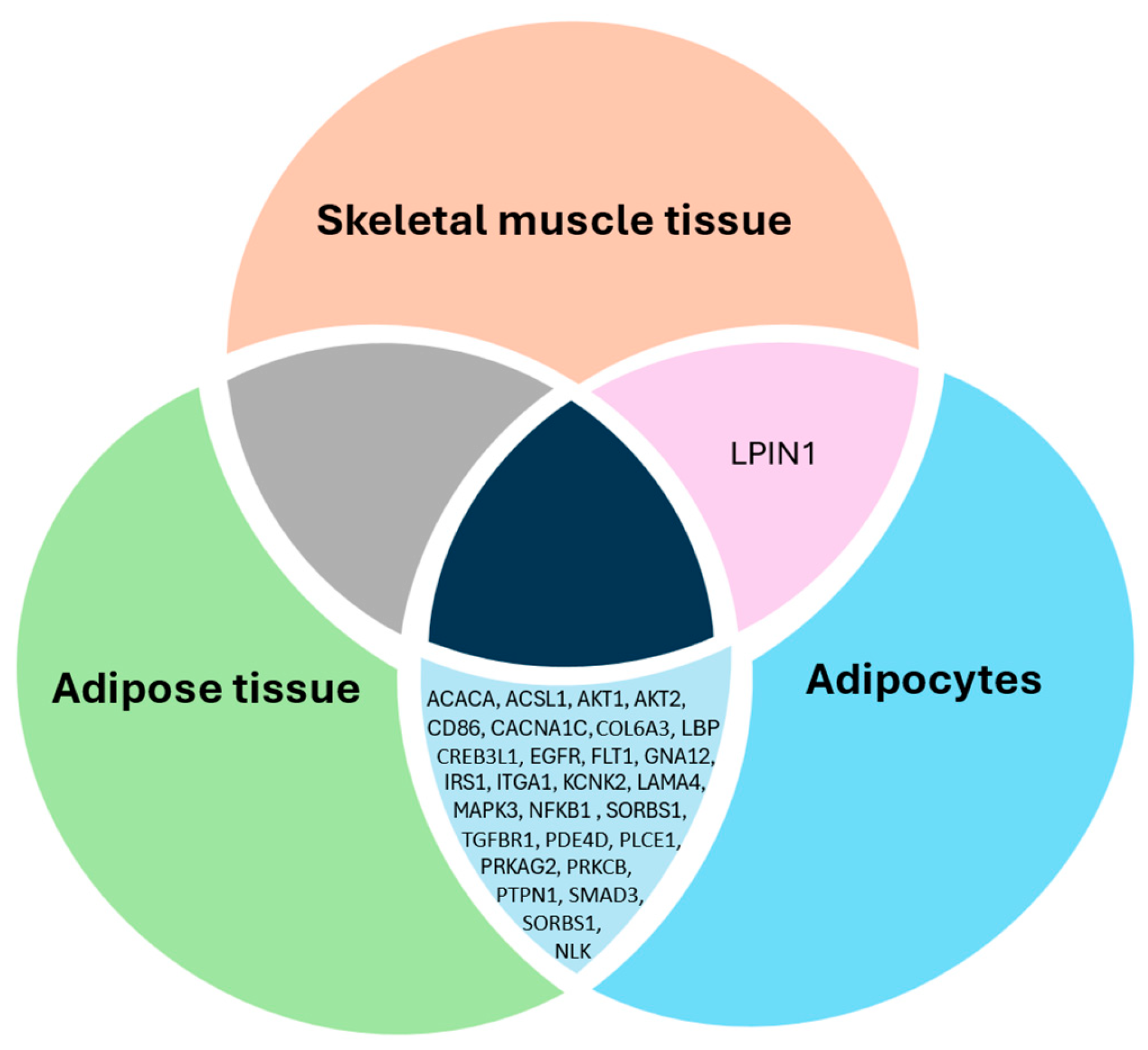

| Ref. | Population Age (y) | Number of Participants (Females/All) | Tissue | Type of Intervention | Duration of Data Collection | Study Design | Statistical Analysis | Main Results | Type of Study | Country |
|---|---|---|---|---|---|---|---|---|---|---|
| Day et al. (2017) [14] | 33–59 | 7/7 (100%) | Muscle | Roux-en-Y gastric bypass (RYGB) | before and 3 months after the intervention | Reduced-representation bisulfite sequencing (RRBS), Illumina HiSeq 2000, pyrosequencing (PyroMark Q96) | A paired Student t test. Pearson correlation analysis | The analysis of SORBS3 revealed 30 CpG hypomethylated sites | Candidate genes | USA |
| Garcia et al. (2021) [15] | 45.1 ± 3.6 | 7/7 (100%) | Muscle | Roux-en-Y gastric bypass (RYGB) | before and 3 months after the intervention | Reduced-representation bisulfite sequencing (RRBS), Illumina HiSeq 2000 | A paired Student’s t-test and an unpaired Student’s t-test. Wilcoxon signed-rank and Mann–Whitney U test | 45 CpG sites were hypomethylated, and 28 CpG sites were hypermethylated | Epigenome-wide association studies (EWAS) | USA |
| Nicoletti et al. (2016) [16] | 35.5 ± 10.1 | 14/14 (100%) | Blood (buffy coats) | Roux-en-Y gastric bypass (RYGB) | before and 6 months after the intervention | Bisulfite conversion; 7900HT Fast Real-Time PCR System | A paired Student t test; Benjamini–Hochberg false discovery rate correction. Pearson’s correlations | Four CpG sites within LINE1, 5hmC, SERPINE-1 and IL6 | Candidate genes | Brazil |
| Wolf et al. (2022) [17] | 36.9 ± 10.2 | 24/24 (100%) | Blood (buffy coats) | Roux-en-Y gastric bypass (RYGB) | before and 6 months after the intervention | Infinium Human Methylation 450K Bead Chip (Illumina) | Shapiro–Wilk test, paired Student’s t-test, Pearson’s correlation analysis | Four CpG sites within three genes: two CpG sites within AGRP, one CpG site within GHRL and POMC | Candidate genes | Brazil |
| Benton et al. (2015) [18] | 44 ± 10 | 15/15 (100%) | Intra-operative subcutaneous and omentum adipose tissue | Roux-en-Y gastric bypass (RYGB) | before and 9–31 months after the intervention (average 17.6 months) | Infinium Human Methylation 450K Bead Chip (Illumina) | A paired t-test, Pearson’s correlation, Benjamini–Hochberg, Bonferroni correction | 3601 CpG sites in SC showed significant differential methylation, within 1889 annotated loci and intergenic regions | Epigenome-wide association studies (EWAS) | New Zealand |
| Andersson et al. (2022) [12] | 44 ± 10 | 22/22 (100%) | Subcutaneous Adipocytes | Roux-en-Y gastric bypass | before, 2, 5, and 10 years after the intervention | Infinium Human Methylation 450K BeadChip (Illumina) | A paired t-test, false discovery rate (FDR), 5% was used as a significance threshold unless otherwise stated. A | 7729 differentially methylated CpG sites (DMS) at 2 years showed no sign of return to baseline. | Epigenome-wide association studies (EWAS) | Sweden |
| Gene | Genetic Variant | Function | Alleles | Position | Reference |
|---|---|---|---|---|---|
| POMC | rs1042571 | Most significantly associated with a higher weight loss after RYGB | A>G | chr2:25383887 | [26] |
| POMC | rs934778 | Has been reported as a risk factor that affects insulin sensitivity | G>A | chr2:25389224 | [27] |
| GHRL | rs27647 | Associated with weight control and obesity; C/C genotype of the growth hormone secretagogue receptor gene experienced most weight loss at 30 months | C>T | chr3:10332468 | [28] |
| LEPR | rs1137101 | Linked to a higher risk of T2D in patients with obesity; improved weight loss for the A/A genotype compared to homozygous carriers of the G allele at 12 and 24 months after RYGB | G>A | chr1:66058513 | [29,30] |
| LEPR | rs1137100 | Could be involved in the development of morbid obesity | G>A | chr1:66036441 | [26] |
| LEP | rs7799039 | Associated with obesity | A>G | chr7:127878783 | [31] |
| PICOS Element | Criteria |
|---|---|
| Population | Female non-pregnant adults (18 years or older) with obesity and no underlying health conditions or diseases |
| Intervention | Bariatric surgery (any type) |
| Comparison | Pre- to post- data |
| Outcome | DNA hypermethylation or hypomethylation in CpG sites |
| Study design | Epigenomic-wide association studies and candidate genes studies |
Disclaimer/Publisher’s Note: The statements, opinions and data contained in all publications are solely those of the individual author(s) and contributor(s) and not of MDPI and/or the editor(s). MDPI and/or the editor(s) disclaim responsibility for any injury to people or property resulting from any ideas, methods, instructions or products referred to in the content. |
© 2025 by the authors. Licensee MDPI, Basel, Switzerland. This article is an open access article distributed under the terms and conditions of the Creative Commons Attribution (CC BY) license (https://creativecommons.org/licenses/by/4.0/).
Share and Cite
Lovett, A.; Hitman, G.A.; Dimitriadis, G.K.; Murphy, A.M.; Tripathi, G.; Duggirala, A. An Epigenomic Meta-Analysis of Differentially Methylated Sites in Pre- and Post-Metabolic/Bariatric Surgery Adult Female Patients. Epigenomes 2025, 9, 32. https://doi.org/10.3390/epigenomes9030032
Lovett A, Hitman GA, Dimitriadis GK, Murphy AM, Tripathi G, Duggirala A. An Epigenomic Meta-Analysis of Differentially Methylated Sites in Pre- and Post-Metabolic/Bariatric Surgery Adult Female Patients. Epigenomes. 2025; 9(3):32. https://doi.org/10.3390/epigenomes9030032
Chicago/Turabian StyleLovett, Agnieszka, Graham A. Hitman, Georgios K. Dimitriadis, Alice M. Murphy, Gyanendra Tripathi, and Aparna Duggirala. 2025. "An Epigenomic Meta-Analysis of Differentially Methylated Sites in Pre- and Post-Metabolic/Bariatric Surgery Adult Female Patients" Epigenomes 9, no. 3: 32. https://doi.org/10.3390/epigenomes9030032
APA StyleLovett, A., Hitman, G. A., Dimitriadis, G. K., Murphy, A. M., Tripathi, G., & Duggirala, A. (2025). An Epigenomic Meta-Analysis of Differentially Methylated Sites in Pre- and Post-Metabolic/Bariatric Surgery Adult Female Patients. Epigenomes, 9(3), 32. https://doi.org/10.3390/epigenomes9030032







